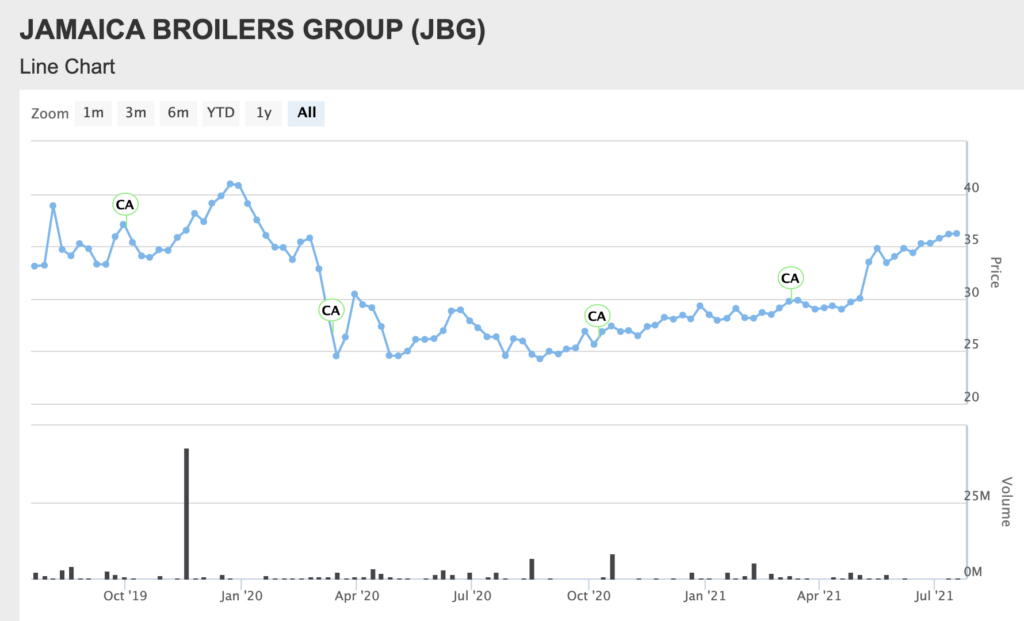Common Stock: Jamaica Broilers Group
Current Market Price: $36.02 JMD
Market Capitalization: $43.2 billion JMD ($280.5 million USD)
*All values in this article are expressed in Jamaican Dollars (JMD) unless otherwise noted.
**The bulk of this analysis is based on the company’s most recent audited financial report, which can be found by following this link.

Jamaica Broilers Stock – Summary of the Company
Jamaica Broilers is a vertically integrated Jamaican poultry company. Their activities include the production and distribution of poultry products, animal feeds, and agriculture items. Their two main brands are “The best dressed chicken” and “Hi-Pro”. In addition to Jamaica, the company operates in The United States and Haiti. The company is expanding in The US via acquisitions and has made investments in a feed mill in Georgia, a hatchery in Pennsylvania, and a processing facility in South Carolina.
Jamaica Broilers was founded in 1958 and is headquartered in St. Catherine, Jamaica
Revenue and Cost Analysis
The company had total revenues of $55.7 billion in the fiscal year 2020, an increase compared to $55 billion in 2019 and $48.3 billion in 2018. Their COGS was $41.1 billion in 2020, representing a gross margin of 26%, equal to their gross margin in 2019.
The company was profitable in both 2020 and 2019. In 2020 Jamaica Broilers had net income of $1.4 billion, representing a profit margin of 2.4%, a decrease compared to 4.3% in 2019. This decrease in profitability was due to increased financing and administrative expenses, as well as a re-measurement of the company’s pension obligation.
Balance Sheet Analysis
The company has a decent balance sheet. They have sufficient liquidity in the near term and a strong base of long term assets. However they are leveraged with significant liabilities including a pension obligation and debt.
Debt Analysis
As of the fiscal year end 2020 the company has $17.2 billion in total debt outstanding, $9.7 billion of which is classified as current. The majority of the debt is denominated in Jamaican dollars and carries an interest rate ranging from 4% to 7%.
Jamaica Broilers Stock – Share Dynamics and Capital Structure
As of the fiscal year end 2020 the company has 1.2 billion common shares outstanding.
Dividends
For the fiscal year 2020 the company paid total dividends of $0.37 cents per share. At the current market price this implies a dividend yield of 1%.
Jamaica Broilers Stock – 3 Metrics to Consider
Debt to Equity Ratio
Total Liabilities/Total Share Holder Equity
$28.3 billion / $16 billion = 1.8
A debt to equity ratio of 1.8 indicates that Jamaica Broilers is leveraged and relies heavily on debt financing to fund itself.
Working Capital Ratio
Current Assets/Current Liabilities
$28.6 billion / $19.6 billion = 1.5
A working capital ratio of 1.5 indicates a sound liquidity position. Jamaica Broilers should not have problems meeting its near term obligations.
Price to Book Ratio
Current Share Price/Book Value per Share.
$36.02 / $13.31 = 2.7
Jamaica Broilers has a book value per share of $13.31. At the current market price this implies price to book ratio of 2.7, meaning the company’s stock currently trades at a premium to the book value of the company.
Jamaica Broilers Stock – Summary and Conclusions
Jamaica Broilers is a solid company. They are vertically integrated and sound financially. They have a strong presence in Jamaica and are expanding in the US via acquisitions. Margins are tight and the company is leveraged, but long term they appear to be well positioned strategically and financially.
I will wait for the company’s next full annual report to be available before making an investment decision. Investors can also consider Caribbean Cement stock.
Disclaimer
This is not investment advice. Nothing in this analysis should be construed as a recommendation to buy, sell, or otherwise take action related to the security discussed. If I own a position in the security discussed, I will clearly state it.
This is not intended to be a comprehensive analysis and you should not make an investment decision based solely on the information in this analysis. I hope this serves as a useful starting point for a more comprehensive analysis, and hopefully draws attention to aspects of the company that were overlooked or merit further investigation. This is by no means intended to be a complete analysis. Again, this is not investment advice, do your own research.